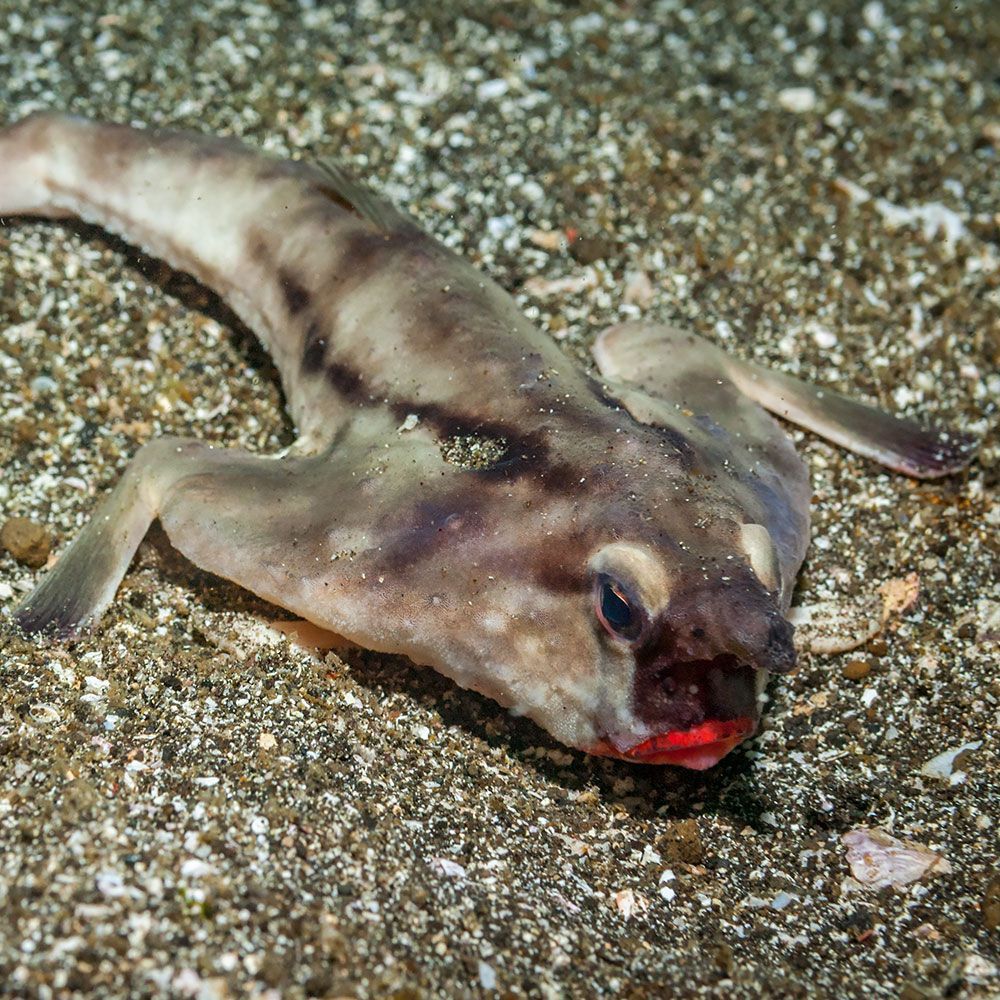Whether you refer to the definition of fish from Wikipedia, Merriam-Webster Dictionary, or the Cambridge Dictionary, a fish is all about:
- “strictly aquatic animal”
- “breathes by taking in water”
- “has fins for limbs”
- “has no digits”
Currently, there are more than 36,600 valid species of fish in the world. So, while these definitions may hold true for a majority of species, it’s not the case for all!
In fact, till now, it’s found that:
- 11 genera of fish, aka “amphibious fish,” have terrestrial locomotion abilities.
- 450 species and 49 families of fish can breathe atmospheric oxygen.
Similarly, there are also some fish that can “walk” or have “legs.”
What are fish with legs?
Fish with legs are the types of fish that can walk. They have 2 or more legs which help them to crawl.
Why do fish have legs?
The fish have legs because of 4 main reasons:
- Running away from their predators
- Going from one place to another quickly in search of food
- Adapting with the environment
- Climbing the reefs
What are the Types of Freshwater Fish with Legs?
Here, the listed fish mainly inhabit lakes and rivers. Out of over 18,000 freshwater fish, these are the most well-known fishes with legs or walking behavior. Most of them use their pectoral fins as pseudo limbs.
1. Chinese Hillstream Loach – Fish with Legs

Native to fast-flowing streams and rivers of the Yangtze River Basin, China, the omnivorous loach, also known as Beaufortia kweichowensis, from the Gastromyzontidae family reaches up to 7.5 cm (3 in).
Along with its fused, unique, flat body, big pectoral fins, vibrant body color and pattern, it looks like riverbed rocks. The fused body resulted in its poor ability to swim and triggered the walking or crawling ability in the fish.
Can Chinese Hillstream Loach Fish Walk?
The territorial Chinese hillstream loach’s extraordinary and sticky pectoral fins help it cling to rocks on riverbeds and aquariums to locomote.
2. Bichir Lapradei – Fish that Walks on Dry Land
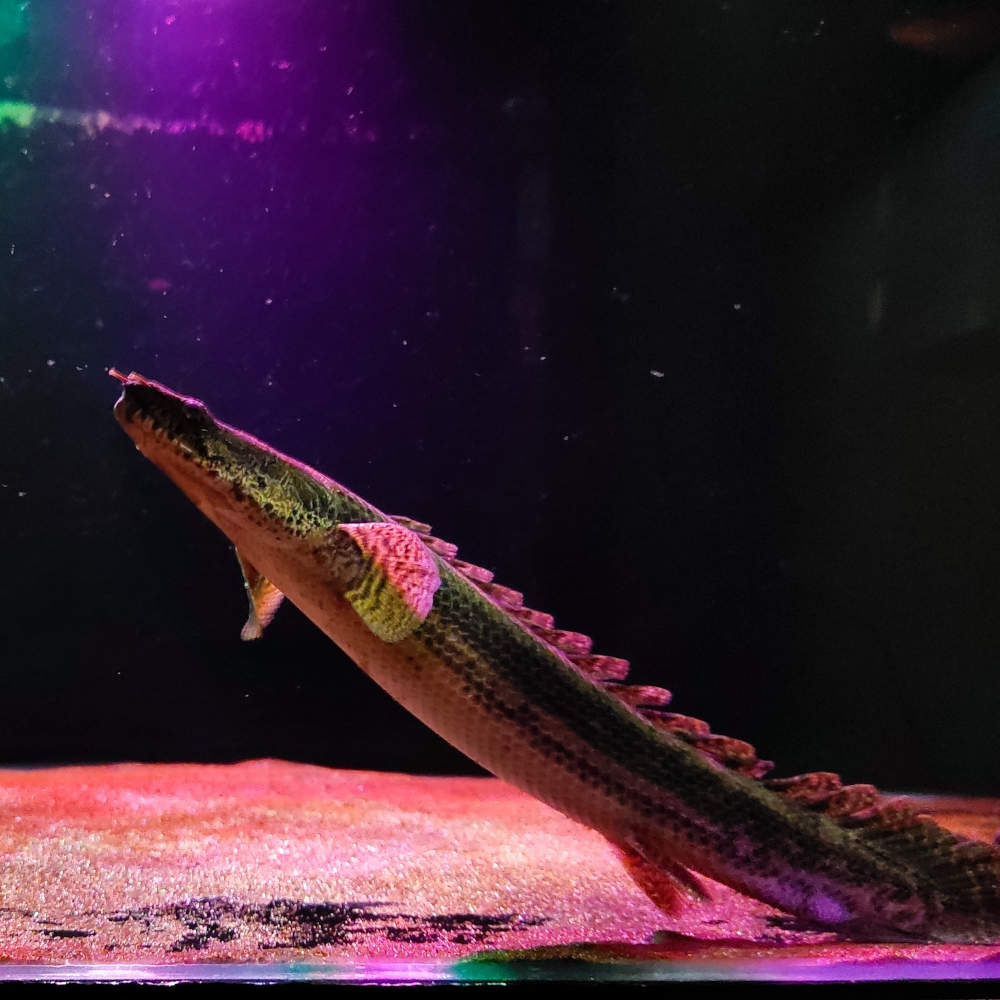
The elongated piscivore of the Polypteridae family, also called Polypterus lapradei, endemic to different African river systems, can be as long as 76 cm (30 in).
Can Bichir Lapradei fish walk?
This fish species is on this list owing to its robust pectoral fins that let it walk short distances on dry land and riverbeds. Other than that, it also breathes atmospheric oxygen during land locomotion using the swim bladder.
3. Short-tailed River Stingray (Potamotrygon brachyura) – Fish with Hardy Pectoral Fins for Walking
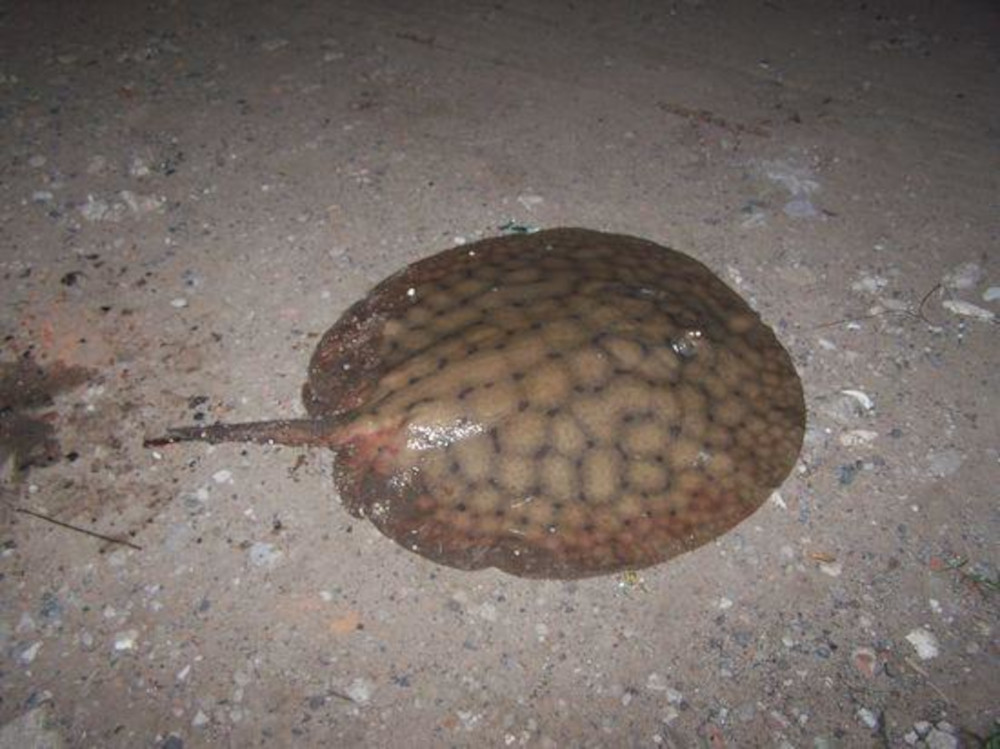
Native to the Rio de la Plata Basin, Uruguay, Paraguay, and Parana Rivers of South America, this giant hump-back stingray from the Potamotrygonidae family grows up to 1.9 m (6.2 ft) in diameter.
How does a Short-tailed river stingray walk?
The peaceful carnivorous bottom feeder has special and hardy pectoral fins, which let it maneuver underwater, dig in the riverbed to hunt food, and also move about on land and escape from predators.
4. Walking Catfish (Clarius batrachus) – Fish with Legs to Crawl
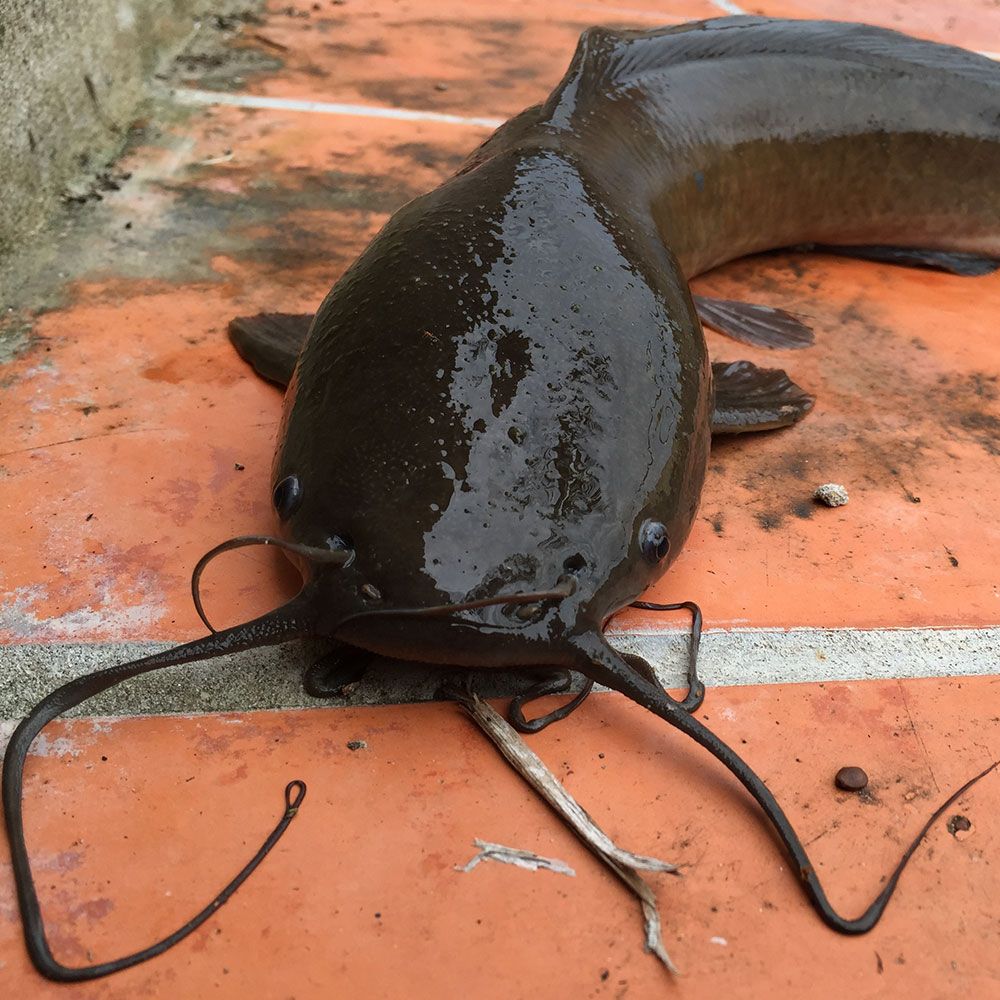
This air-breathing fish from Southeast Asia has an elongated body reaching up to 0.5 m (1.6 ft). The gray-to-brown carnivore is usually spotted in streams, rivers, ponds, swamps, temporary pools, and rice paddles.
How does a Walking Catfish Walk?
The assertive fish is named owing to its pectoral fins that help it walk and wiggle across shallow, muddy water bodies and dry surfaces. However, the walking motion is much more like a snake’s motion.
Its abilities were triggered for survival, like to seek food or a new habitat if the current one dries up.
5. West African Lungfish (Protopterus annectens) – Fish with Fins as Legs
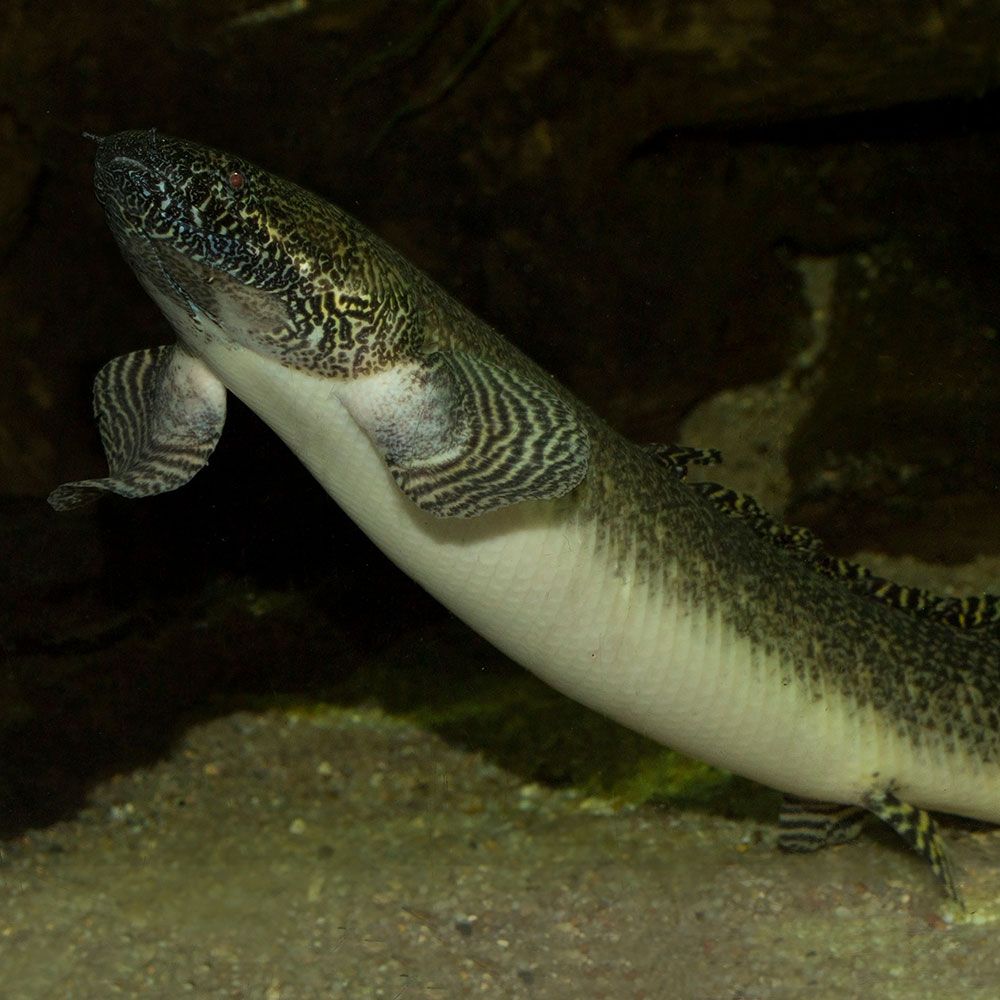
This meter-long (3.3 ft) semi-aggressive lungfish, found throughout Africa, belongs to the Protopteridae family. The carnivore is popular for surviving for 3.5 years without food. It’s also known to have existed even in the Jurassic period.
How does West African Lungfish Walk?
The pelvic and pectoral fins of west African lungfish are twice and thrice as long as the head, respectively. They are used as a locomotive tool for the fish to navigate, glide, or “walk” through muddy and shallow waters and on land.
If it’s active during the dry season, it chooses to find another habitat. Its fins are one of the major proofs of fins evolving into limbs.
6. Northern Snakehead (Channa argus) – Fish that Walks with Spine
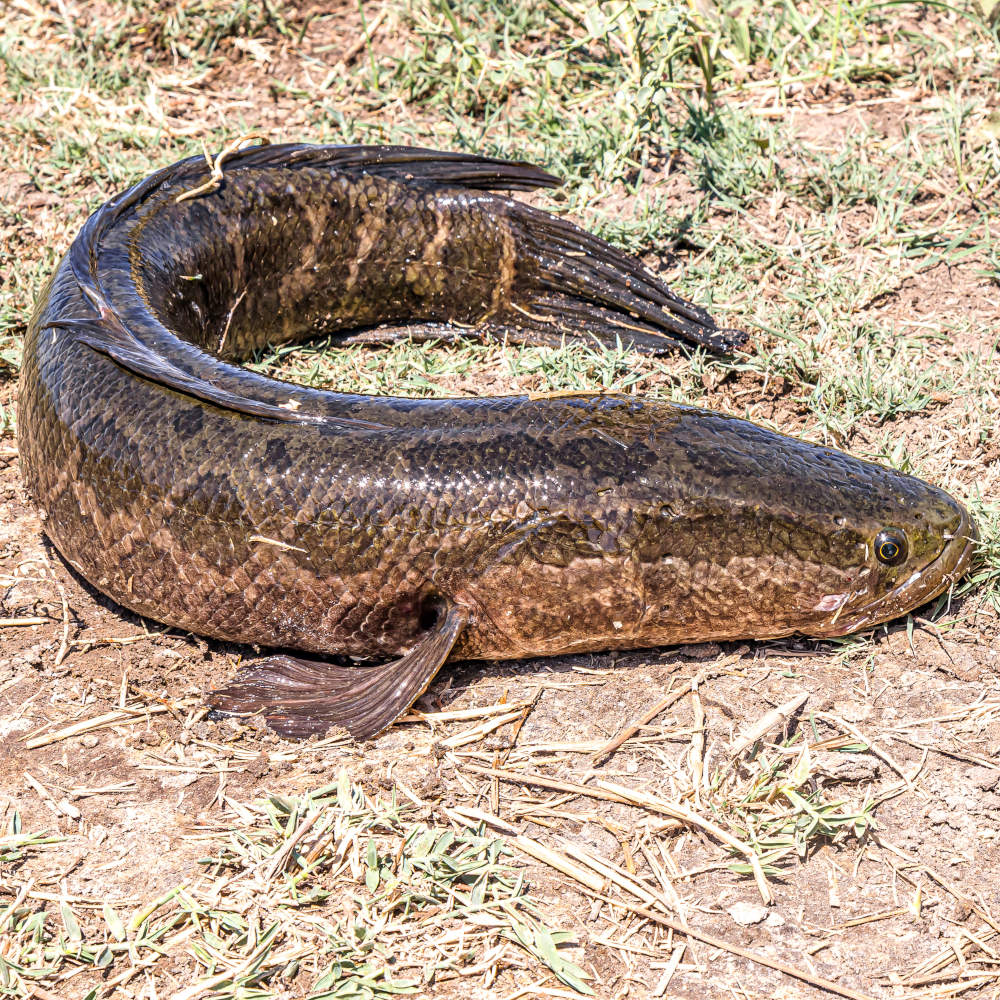
Originating from China, North and South Korea, and Russia, East Asia, the aggressive carnivorous species belonging to the Channidae family reaches up to 150 cm (59 in).
In fact, the snakehead is known to walk on damp land or until it stays wet to find new sources of water. Furthermore, its thick scales protect it from scratches while it transverses.
Compared to most other species on this list, it doesn’t depend on its fins to act at pseudo-limbs for locomotion. Instead, its walking is about wriggling across the land with the help of its entire spine and core.
What are the Types of Saltwater Fish with Legs?
Next, we’ll learn about the most common saltwater fish with legs, residing in the deep seas and oceans.
Some of these species either use their limbs to walk or leap, catch prey or sneakily get near to prey, leap across the ocean bed, or even get out of water.
7. Pacific Leaping Blenny (Alticus saliens) – Fish that Leaps with Legs
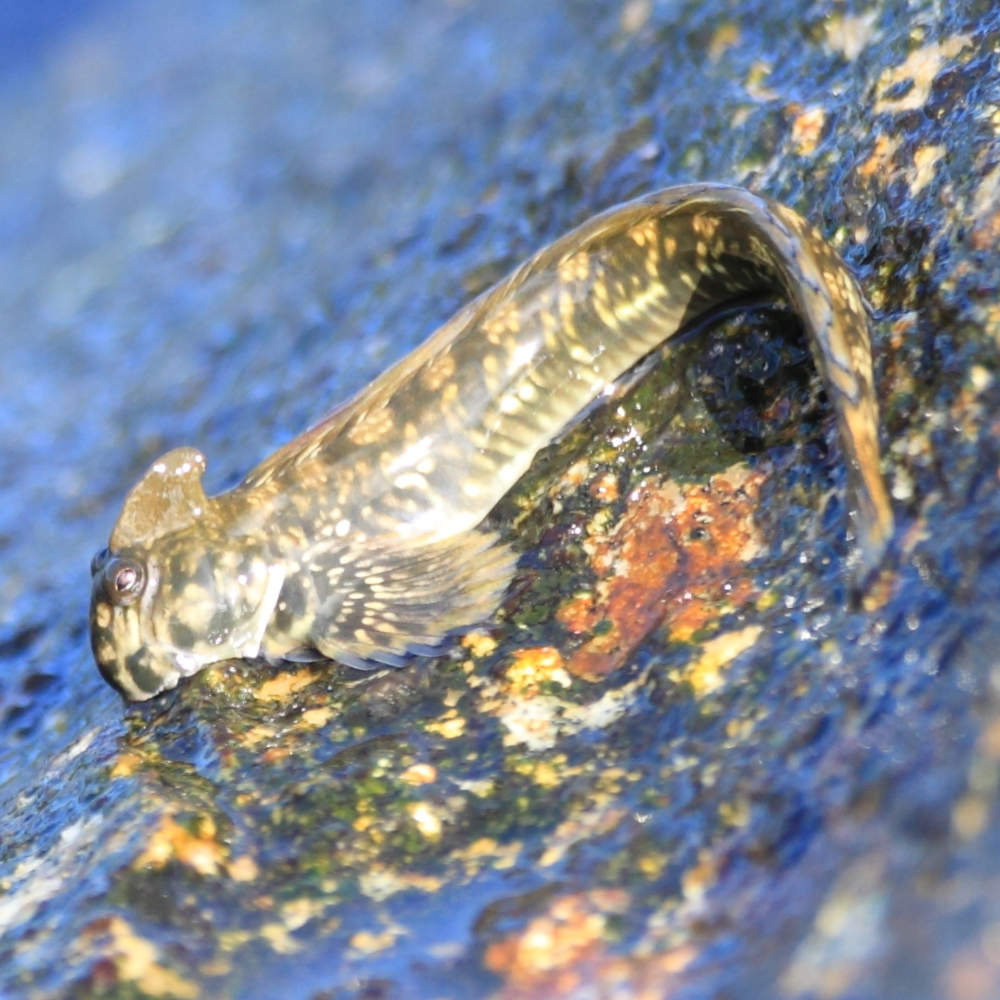
This combtooth blenny of the Blennidae family calls the Pacific and Indian Oceans its home. The worm-shaped species is found around the Society Islands, Ryukyu and Bonin Islands, Red Sea, Mariana Islands, and Queensland, Australia.
The Pacific leaping blenny jumps on the land to transverse to its destination. It avoids getting completely submerged in water. During low tides, it tries to steer clear out of the water.
It jumps on the dry stones until it reaches a safe space where it won’t get submerged during the high tide. This also helps the fish leap from one rock crevice to another to protect itself from potential predators.
8. Red Gurnard (Chelidonichthys cuculus) – Fish with 6 Visible Legs
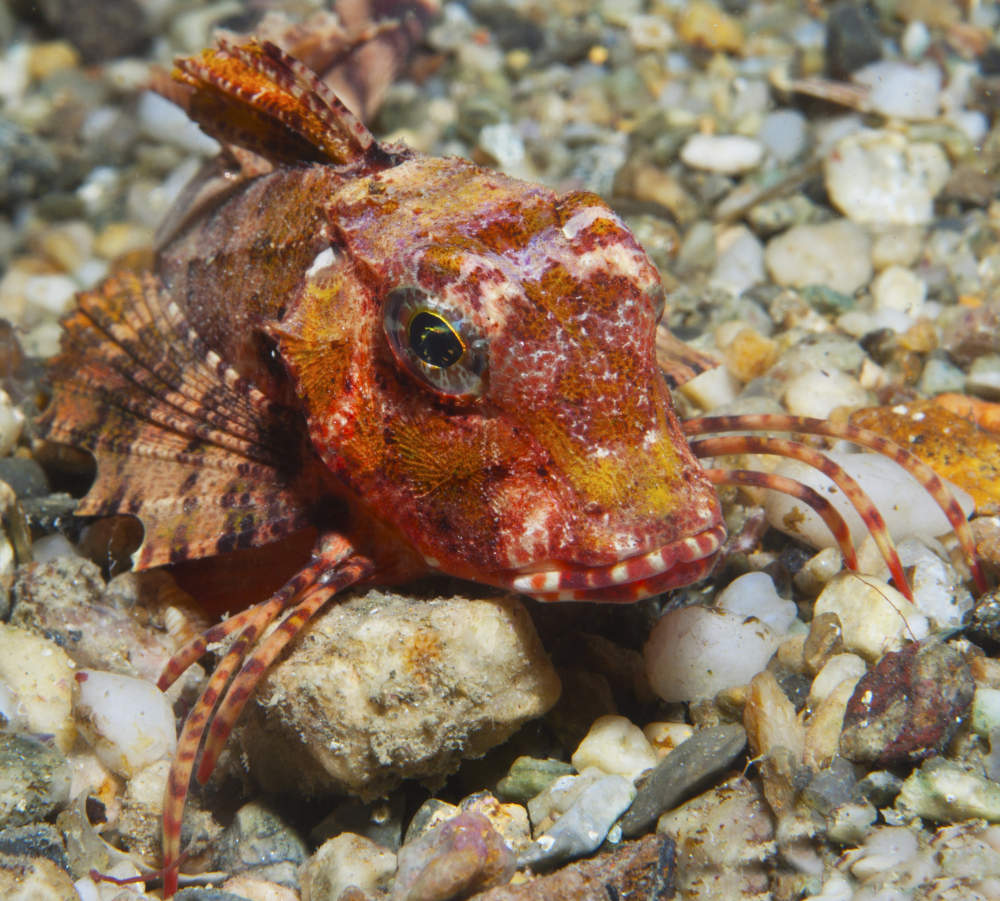
Hailing from the Triglidae family, the fish is found in the eastern Atlantic Ocean, Mediterranean Sea, and Black Sea, around southern Scotland, Norway, Mauritiana, Azores, Madeira, and Canary Islands.
This peaceful carnivorous bottom-dweller reaches up to 70 cm (27.6 in).
The lowermost three spines of its pectoral fin look much like its legs and have chemoreceptors, which allow it to smell prey. So, the red gurnard digs the seabed to seek prey and walks across the ocean bed using these pseudo legs.
9. Epaulette Shark (Hemiscyllium ocellatum) – Shark with Legs

This long-tailed carpet shark of the Hemiscyllidae family inhabits the shallow tropical waters of the western Pacific Ocean of New Guinea and the eastern coast of Australia. It mostly grows up to 1 m (3.3 ft).
The slender carnivorous epaulette shark’s strong fins help it wriggle and push its body forward and thus walk with paddled-shaped fins.
This walking ability wasn’t present since the beginning. It has evolved over time to survive through drastic seasons like low tides.
10. Red-lipped Batfish (Ogcocephalus darwini) – Fish with 4 Legs

From the Ogcocephalidae family, the peaceful piscivorous batfish is native to the Pacific waters around the Galapagos Islands and Peru and grows up to a 40 cm (16 in) length.
Named after its bright red lips, the iconic bottom-dweller is a poor swimmer. But it is popular for the anal, pectoral, and pelvic fins that help it walk on the ocean bed.
The limb-like fins also help the fish perch, dig for food, and catch prey. You’re more likely to see the fish walk rather than swim.
Can you see Red-lipped Batfish Walking?
We cannot see the red-lipped batfish because it prefers to walk across the ocean floor more, humans can rarely catch a glimpse of the species.
11. Shortnose Batfish (Ogcocephalus nasutus) – Fish with 4 Hind Legs
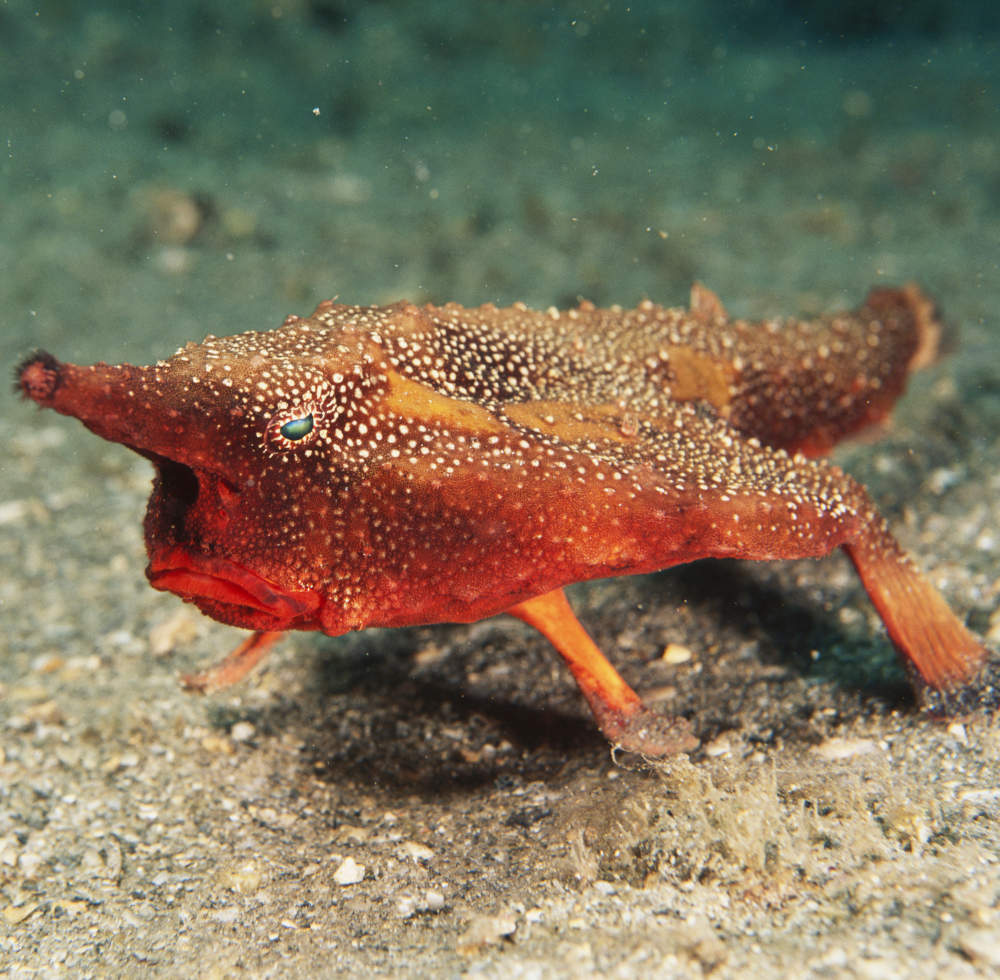
Another species from the Ogcocephalidae family of anglerfish group that reaches up to 38 cm (15 in).
Spotted in the Western Atlantic Ocean and Caribbeans, the spooky-looking peaceful omnivore uses its evolved ventral fins to skip away through the ocean floor, looking for food sources.
The pectoral fins have also receded towards its rear and function as hind legs. It seems much like a four-legged creature and less like a fish.
12. Warty Frogfish (Antennarius maculatus) – Fish with Limbs

This anglerfish of the Antennariidae family is native to the Indo-Pacific regions of Mauritius, Indonesia, Singapore, Papua New Guinea, Solomon Islands, and Reunion Island. The voracious carnivore grows up to 15 cm (5.9 in).
The generally peaceful yet strong fish uses its leg-like pectoral fins to stabilize itself and walk across the ocean bed and perch on corals.
With this walking or angling mannerism, the fish ambushes prey with its big mouth. It also uses limb-like fins to cover itself from prey and drag or hold prey.
13. Little Skate (Leucoraja erinacea) – Fish with Modified Legs
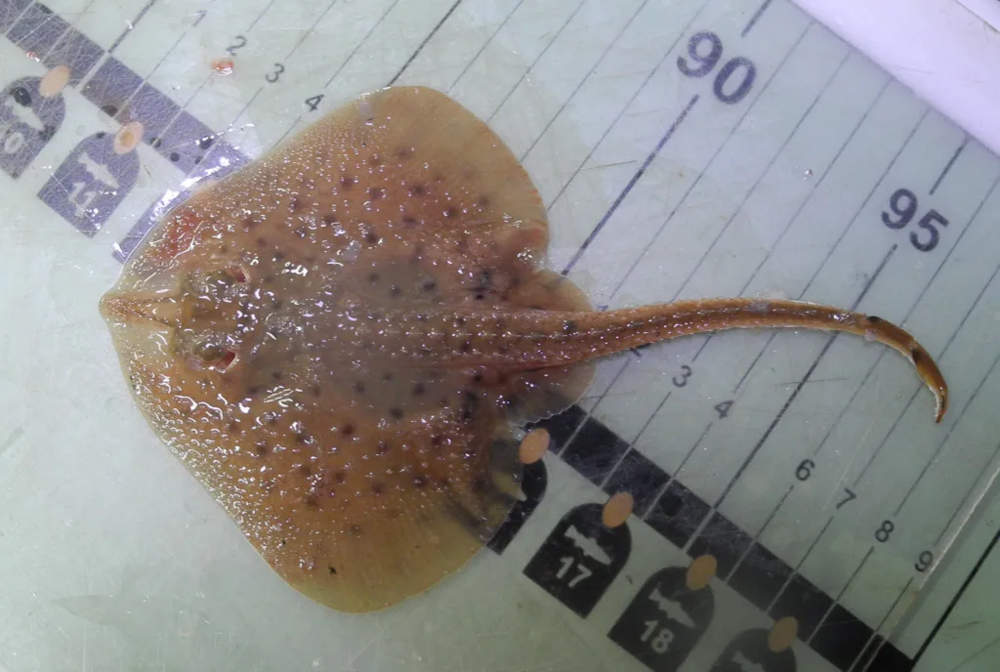
From the Rajidae family, the invertivorous fish is an inhabitant of the western Atlantic Ocean around Canada, Nova Scotia, USA, and North Carolina and grows up to 51 cm (20 in).
The species stays on the ocean floor and moves about using its modified fins. It helps the fish get closer to prey without creating water turbulence that may alert the prey.
Moreover, research shows that the nerve networks that govern its “walking” ability are identical to those in mammals.
Which Types of Fish with Legs can Live in Any Environment?
There are some remarkable fish with legs that can stay in varied combinations of freshwater, marine water, as well as brackish environments.
The ones on this list, however, aren’t as skilled as the others. Most of them locomotate by skipping or wriggling. Despite their awkward “walking,” they’ve been pretty popular.
14. Climbing Perch (Anabas testudineus) – Fish with Legs to Climb
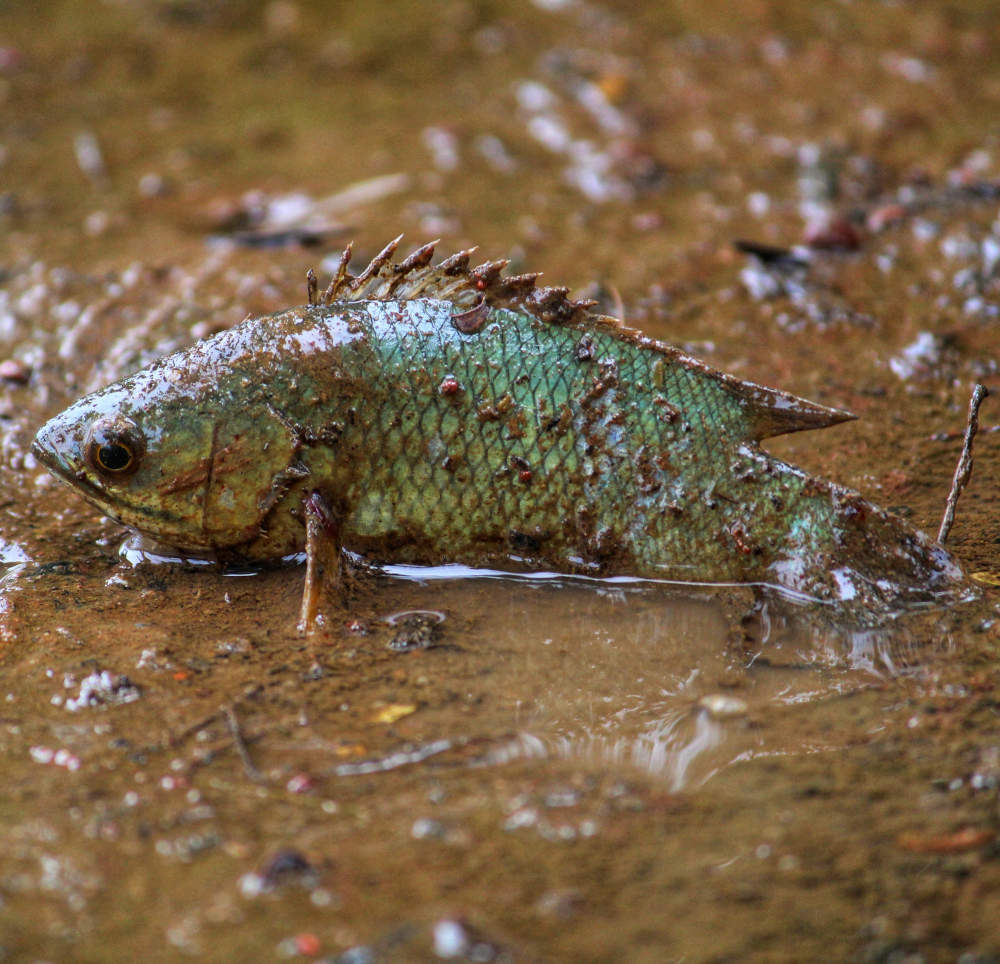
The slightly aggressive climbing perch is a species complex of the Anabantidae family. Native to brackish and freshwaters of vast regions from Pakistan, Bangladesh, South China, India, and more, the invasive fish grows up to 25 cm (9.8 in).
It wriggles, crawls, and walks on land for short distances using the strong, large pectoral fins. Often, the omnivore jerks out of the water using the tail and spines on the lower side of the gill covers.
This ability is a result of its survival instinct in a number of situations. It might be because:
- The water level has decreased, and the fish wants to leave the muddy areas and locomote to habitats with more water.
- Its habitat is overcrowded, and it’s in search of a more comfortable and less populated area.
- It’s in search of sources of food.
15. Barred Mudskipper (Periophthalmus argentilineatus) – Salamander like Fish with 2 Legs

In general, all mudskippers are walking fish, but this is the most popular of them all.
The amphibious territorial carnivore from the Oxudercidae family grows up to 19 cm (7.5 in) and is native to the African coast of the Indian Ocean, the western Pacific Ocean, Ryukyus, and around Australia.
The salamander look-alike fish is named after its jumping terrestrial locomotion on the mud. The side pectoral fins are much more toward the head and jointed. This makes its function similar to limbs.
How does Barred Mudskipper Walk?
Its overall walking ability depends on the fins, along with the pushing of the tail and lateral flexing. This helps the fish move by skipping and climbing low-hanging scrubs and tree branches. The tail also helps the fish glide around in the preferred direction in mud.
Mudskippers are known for their leaping up to 61 cm (24 in). It’s also said that these species can jump as high as 2 feet above the ground.
16. Alligator Gar (Atractosteus spatula) – Alligator Like Fish that can Walk on Land
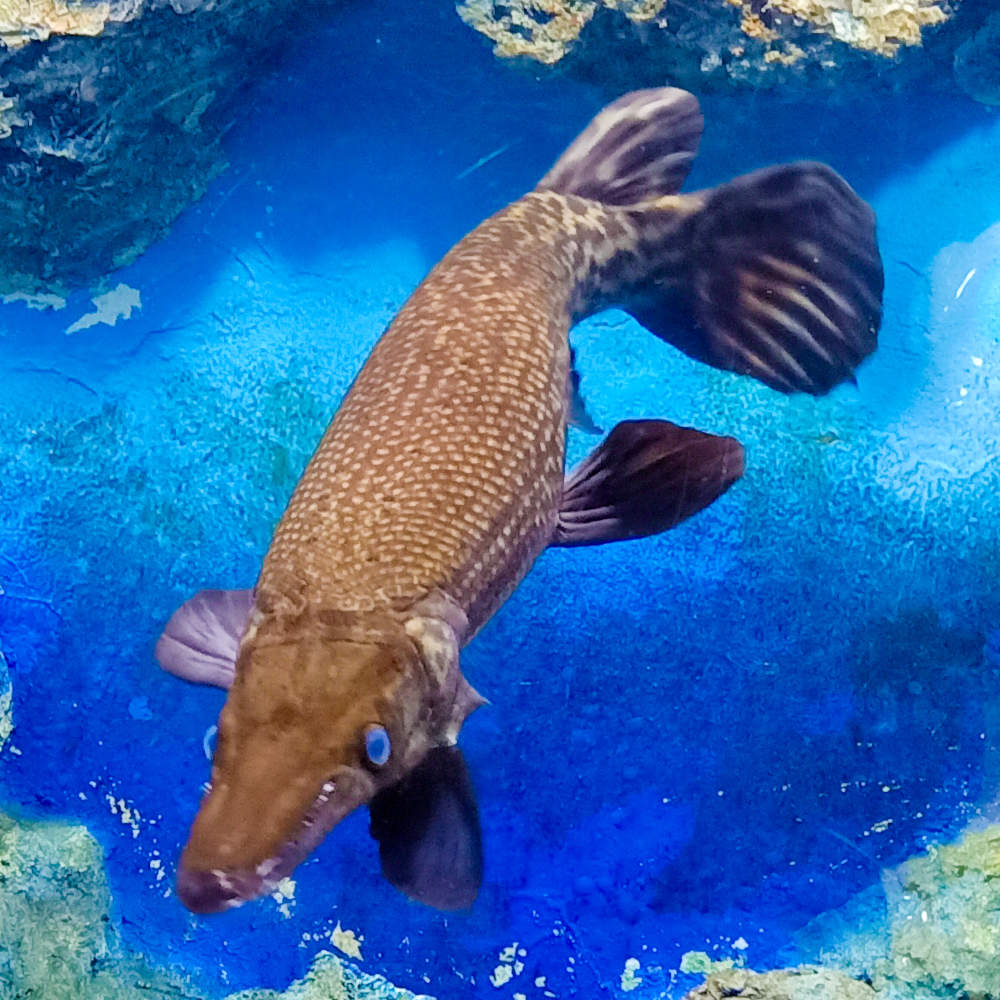
The slow-moving and peaceful carnivore from the Lepisosteidae family is found in the lakes and reservoirs, lowland river backwaters, brackish waters of bays and estuaries of the southern US, the Mississippi River basin, the Gulf of Mexico, and the Econfina River.
The alligator gar’s spine is similar to tetrapods, with its interlocking and fully ossified vertebrae. Unlike other gars, the fish comes out of the water only when in search of food or to escape from predators in the water. The species survives up to 2 hours on land.
However, information about whether or how it locomotes on land is unknown.
17. Largescale Four-eyed Fish (Anableps anableps) – Fish that can Slide
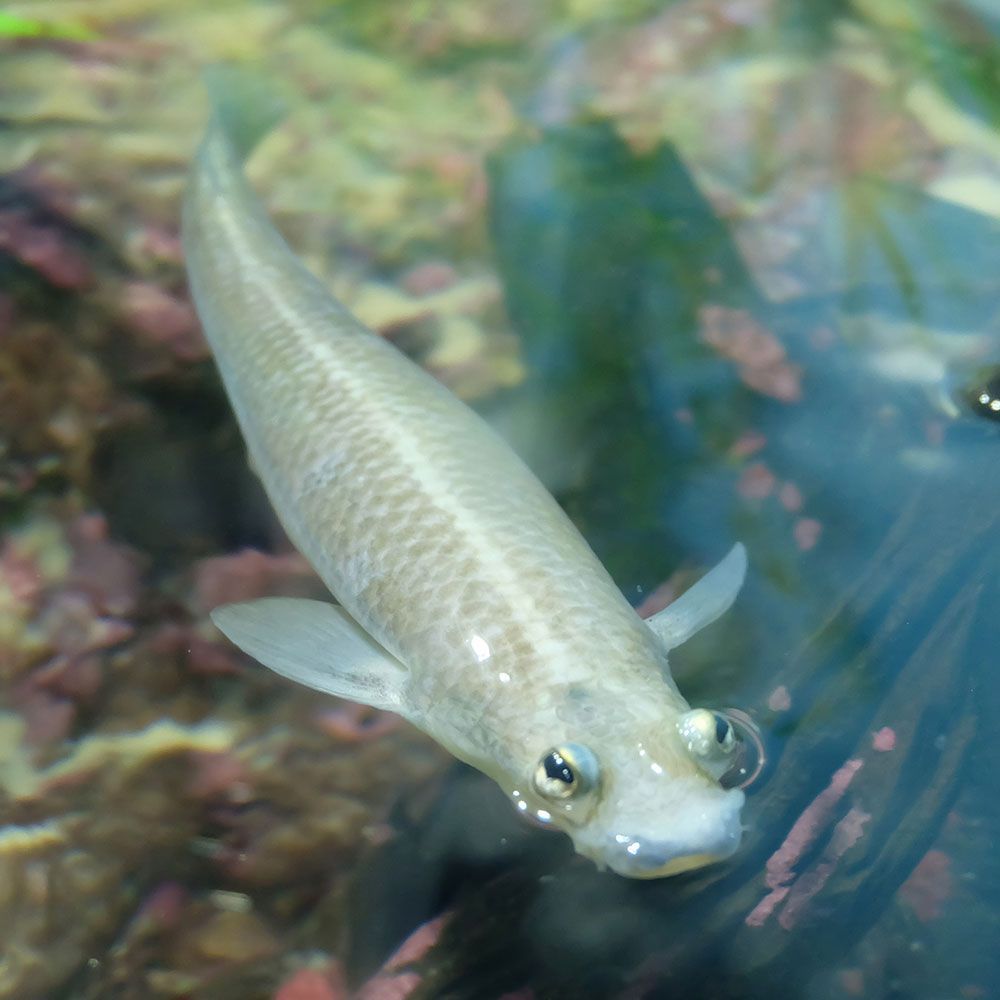
From the Anablepidae family, the slender, elongated four-eyed fish grows up to 30 cm (12 in) and inhabits tropical waters of the western Atlantic Ocean, the southern Caribbean Sea, and the Amazon River.
It can’t particularly move out of water and walk on dry lands. But during low tides, it either moves along with the receding water during low tides. Or, it waits in the muddy regions until the high tide. Meanwhile, it slides about the mud using its fins.
What are the Types of Rare Fish with Legs?
Moving on, this list is all about popular yet scarce and endangered species. These fish are protected because they are “Naturally Threatened”. Two of these walk underwater, while the other one walks through the rocks under waterfalls.
18. Cave Angelfish (Cryptotora thamicola) – Rock Climbing Fish with Legs
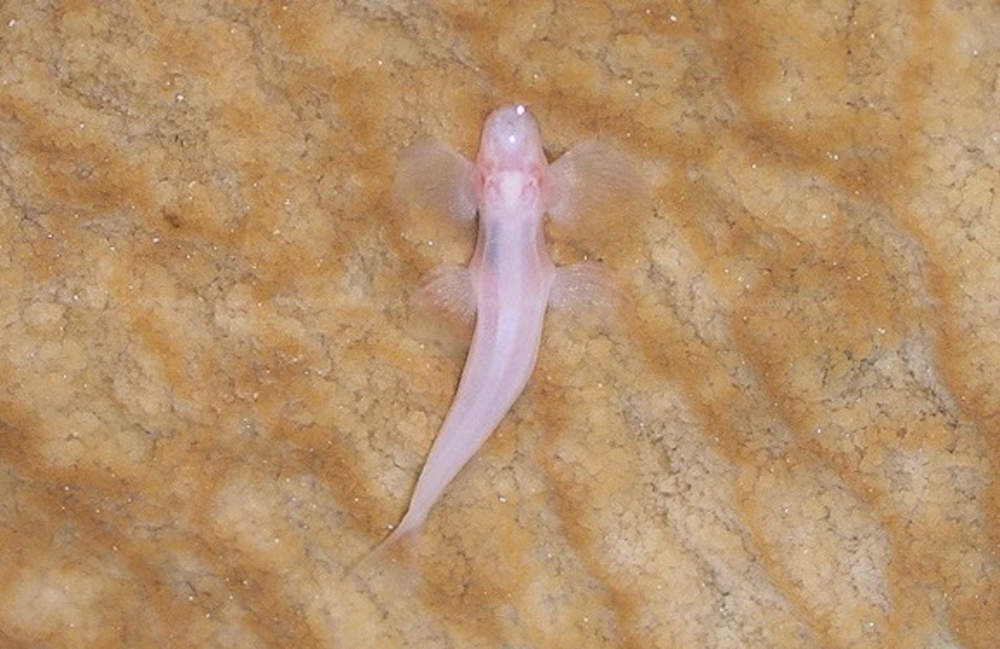
The blind algivorous cave angelfish of the Balitoridae family from Mae Hong Son Province, Thailand, reaches up to 2.8 cm (1.1 in).
It can grab on terrain and climb up the rocks of fast-flowing waterfalls, just like terrestrial vertebrates.
This walking behavior is a unique example of convergent evolution into a tetrapod. The mannerism looks similar to that of the diagonal couplets lateral sequence of salamanders.
Its sturdy pelvic girdle attached to the vertebral column supports the entire body weight while it walks. This proves the evolutionary changes of the first vertebrate starting to walk on land.
Due to its “Vulnerable” status, it’s not possible to research the fish’s walking behavior to know further.
19. West Indian Ocean Coelacanth (Latimeria chalumnae) – Nocturnal Fish with Legs
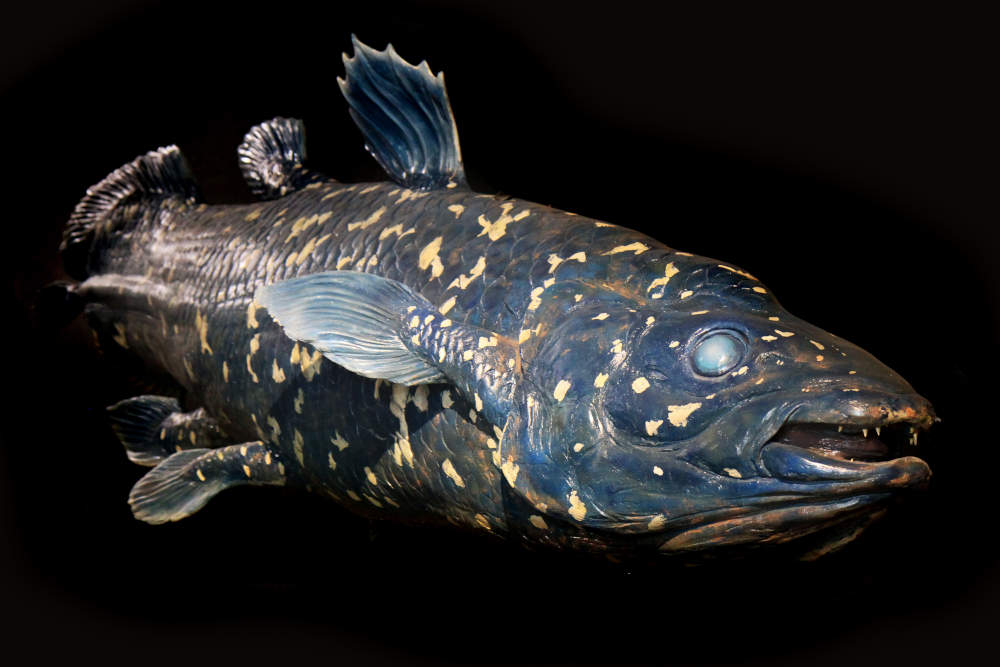
The cave-dwelling piscivore, generally spotted in the western Indian Ocean, around the Comoro Islands, Mozambique, and Madagascar, reaches up to 2 m (6.5 ft) and lives up to 100 years.
Initially believed to have gone extinct millions of years ago, the “Critically Endangered” species was caught on the South African coasts around 1938.
The nocturnal predator has strangely shaped lobed, thick lateral fins attached to the abdomen, which look like limbs. The bony, meaty, jointed fins work as pseudo limbs and let the fish “walk/run” like a calf on the ocean floor.
They help the saltwater fish navigate through bumpy terrain underwater and swim upside down and backward. But some say that nobody noticed the fish actually “walking” on the ocean floor. Instead, they have seen the fish paddling in the water, which makes it look like walking.
20. Spotted Handfish (Brachionichthys hirsutus) – Slow Moving Fish with Legs
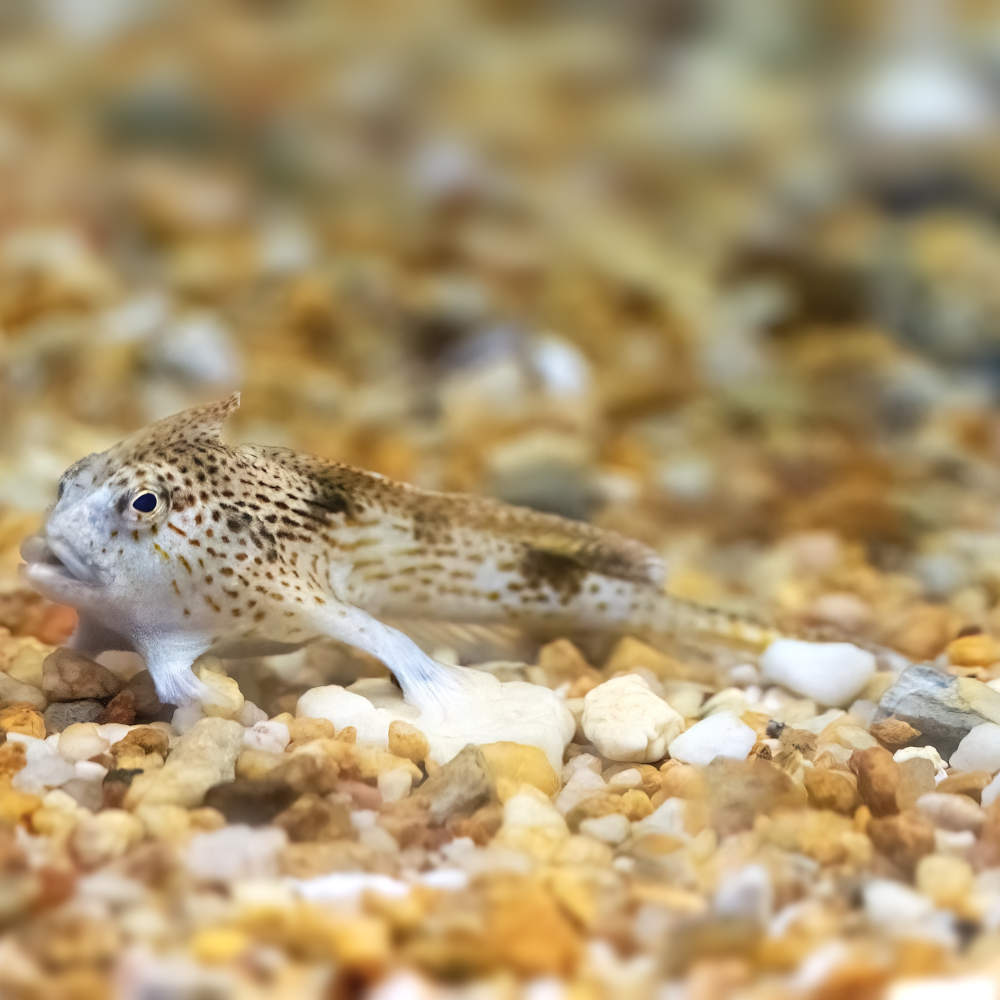
This Branchionichthyidae family member is a unique anglerfish from Tasmania, Australia, growing up to 12 cm (4.7 in).
The slow-moving invertivore prefers to “walk” using its hand-like pectoral fins. But this walking is only possible underwater as the fish can’t live out of water.
Though the fish’s other fins are well-developed, it can only swim short distances, especially when threatened. Other times, it walks and leaps on the ocean floor in search of food.
Other cousins of the spotted handfish also have the same walking ability, but this is the most popular one.
What are the Types of Extinct Fish that Could Walk on Land?
The evolution of fish began hundreds of millions of years ago. Scientists have spotted fossils of those remarkable legged fish of all times in different areas of the world. They have even found a connection between the land vertebrates and fishes.
21. Eastmanosteus pustulosus – Carnivorous with with Legs
The carnivorous fish is from the middle to late Devonian period. While there’s no definite evidence of Eastmanosteus pustulosus walking on land, it certainly had several interesting characteristics.
Unlike most fish and similar to the appendages of tetrapods, the species had a shoulder and skull separation. The limb-like joint indicates the possibility of the fish being a tetrapod as well.
22. Leptolepis koonwarriensis – Ancient Fish that could Walk
The Leptoleptidae family member used to look much like the modern herring and grew up to 8.5 cm (3.35 in).
Leptolepis koonwarriensis existed during the Jurassic period, and the fossils were found at Rabbit Valley in Colorado.
Just like the rigid spine of tetrapods, the fish has a fully ossified vertebral column, unlike most others with more cartilage. This signifies that the fish might have had the walking ability.
23. Panderichthys rhombolepis – Fish with Thick Limbs
The meter-long (39 in) Panderichthyidae family member existed around the Late Devonian age about 380 million years ago.
Panderichthys rhombolepis shared many similarities with the tetrapods and lungfish of modern times. It had different distal radial bones and humerus, radius, and ulna bones.
It’s believed that it used to walk on land with the help of its thick limb-like fins. Many say that the omnivore is an intermediate between the first-ever four-legged animals on land and primitive fish.
24. Sauripterus taylori – Fish with Strong Leg Muscles for Walking
The rhizodont lobe-finned primitive species from the Devonian period showed signs of being a tetrapod. It lived in the northeastern US rivers and lakes.
After researchers examined the structure and shape of the fin rays of its fossils around a rock, they found that it had robust fins to prop itself up over the water.
The fish is known to have strong muscular fins, humerus, radius, and ulna bones, and differentiated distal radial bones like tetrapods.
25. Tarrasius problematicus – Eel Lookalike that could Walk
The 345 million-year-old Tarrasiidae family member is known to have had a tetrapod-like five-segmented spine.
Tarrasius problematicus is not considered a transitional fossil (like Tiktaalik roseae and Panderichthys rhombolepis). But it’s definitely a prime example of convergent evolution.
The eel look-alike used to inhabit shallow waters around Scotland.
26. Tiktaalik roseae – Fish with Hind Limbs for Walking
Another Late Devonian Period fish (375 million years ago), which is also an important transition fossil, signifies the evolution of swimming fishes to four-legged vertebrates.
Tiktaalik roseae fish had strong “limbs” to help it support its entire body and prop up in shallow waters. Its unique pectoral fins and hind limb-like structures also helped the fish maneuver through shallow water bodies.
Much like tetrapods, the species has a shoulder-skull separation, functional intra-fin joints, and humerus, radius, and ulna bones.
However, there is still some ongoing debate regarding the carnivore’s connection to tetrapods.
What do Fish Legs Help With?
Fish legs help them with the following:
- Hunting: Some species grab their prey with these extraordinary fins, while others step out of the aquatic habitat on the land to seek food in the nearby areas.
- Fleeing: Some use these “legs” to get away from predators quickly. For instance, if the predator is in the water, it leaves the water and hides on land. If the predator is on land, it hides in water.
- Camouflage: A few fish use these limbs to simply camouflage themselves in their surroundings (like the warty frogfish).
Frequently Asked Questions
What is the fish with legs called?
A fish with legs is called a Walky fish because of the simple reason that it can walk using its legs. Most fish have 2 or 4 legs.
How many species of fish have legs?
We have listed 26 different species of fish that have legs. These combine the freshwater, saltwater, rare and extinct species of fish.
What is the name of the four legged fish?
There are several four legged fish which include Tiktaalik, Red-lipped Batfish, Shortnose Batfish and Warty Frogfish etc.
Do fish have human like legs?
Fish don’t have “true legs or feet” like humans or other land animals. However, since time immemorial, some species have strong fins that work just like legs for them.
What do you call a fish with two legs?
A fish with two legs is called a Walky fish. Fish have the ability to walk if they are blessed with two legs.
What do you call a fish with no legs?
A fish with no legs doesn’t have any special name. Its categorized based on the type of species that it is.
A word from FishInAquarium
Though fish aren’t supposed to have legs or walk, the world has always been full of fascinating exceptions.
Fish with legs have always existed and evolved – they still exist… and who knows? Ages later, the legged fish of current times may evolve into something more mesmerizing!
If this article quenches your curiosity, don’t forget to share it with your friends. Let them marvel at these wonderful water creatures as well.
Have more questions? Feel free to drop us an email, and we’ll answer you right away!

